Welcome to Tsingy de Bemaraha, an unforgettable place where lemurs leap between knife-sharp limestone pinnacles. A place where nature and adventure go hand in hand.
‘It’s there, look, in the tree hollow’.
‘Where?’ I asked Tsara, our guide.
‘There! In the tree hollow! Can you see its eyes?’
I tried and tried, but I couldn’t see anything other than an ordinary-looking tree. Following Tsara’s instructions, I focused on the hollow. Finally, I saw it.

Two bulging eyes: a tiny grey sportive lemur, one of eight species found in Tsingy de Bemaraha National Park. We hadn’t even got into the Tsingy yet, and we had already seen two types of gecko and one iguana wandering about, plus the tiny lemur and a Decken’s sifaka, dancing from one tree to another with its long, delicate limbs.
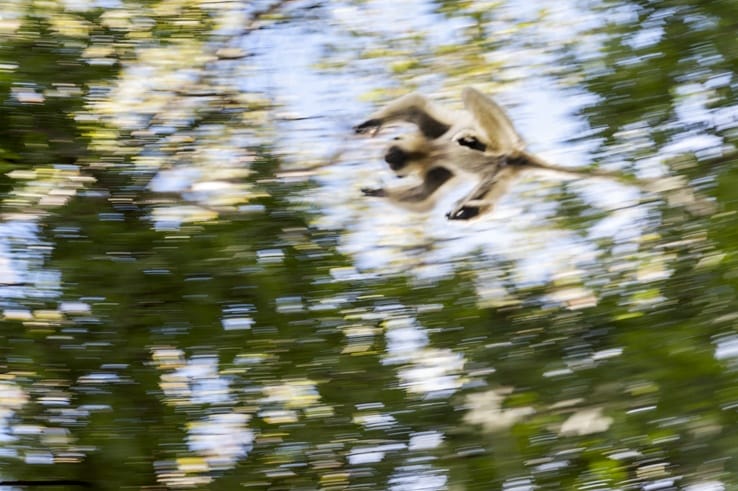
Tsingy de Bemaraha is one of those places where I had promised myself I would go, one day. I remember seeing pictures of it on a Nat Geo cover at my dentist’s, when I was about fifteen or so. I was mesmerised by the look of the place. It was an aerial picture; I saw limestone spires, as sharp as needles, stretching across a double-page spread.
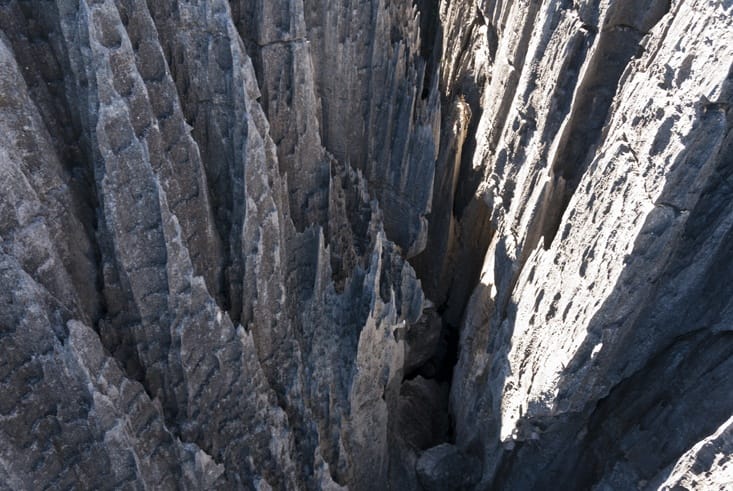
A landscape that didn’t look like it could support life. Yet, looking through the magazine, I saw the hypnotic eyes of lemurs, peering from the rocks. I saw bright-coloured lizards and slate-grey chameleons, birds of prey and weird-looking insects.
The Tsingy are an island of biological diversity within Madagascar, an island that is so biologically unique it has been called ‘the eighth continent’.
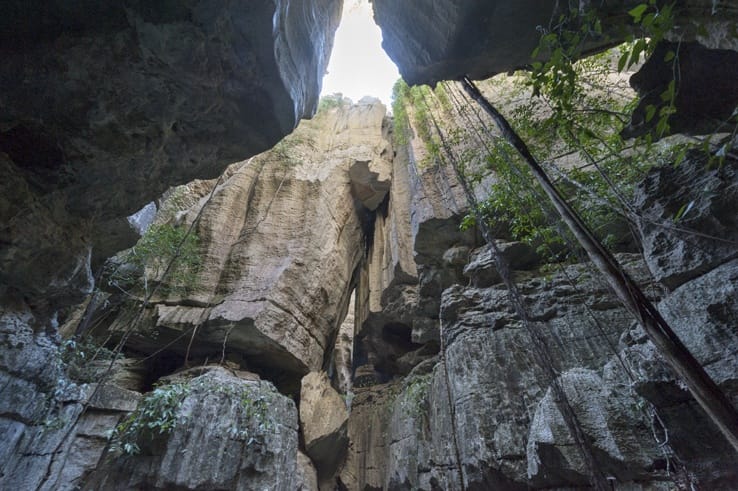
Where is Tsingy de Bemaraha National Park?
Fast-forward another fifteen years, and I finally fulfilled my wish. Tsingy de Bemaraha is not an easy place to get to. There are no paved roads to Bekopaka, the gateway village to the national park. Only a potholed track from Belo-sur-Tsiribihina, where we ended our Tsiribihina river trip. We drove 100 km in 4 hours – not a bad average for Madagascar.
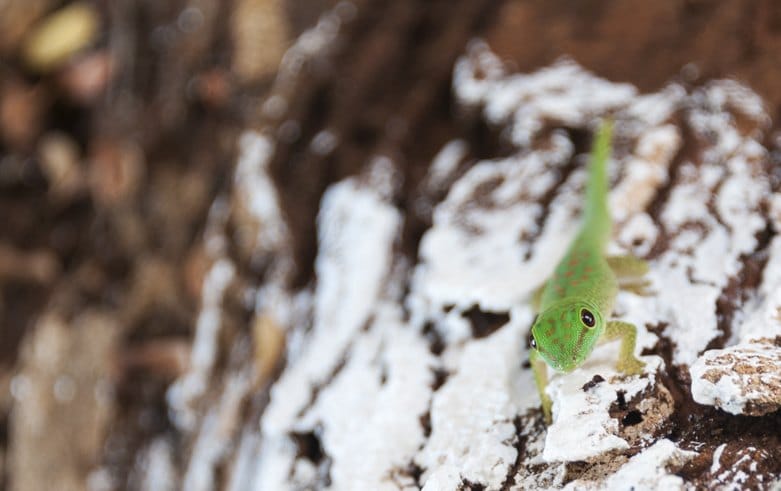

Petit Tsingy
The National Park is divided in two sections; Petit and Grand Tsingy. Petit Tsingy was the first one we visited. There, the limestone pinnacles are about 20 meters high. We trekked through the forest with our local guide Tsara, admiring the wonderful biological diversity and the way trees have adapted to the environment.
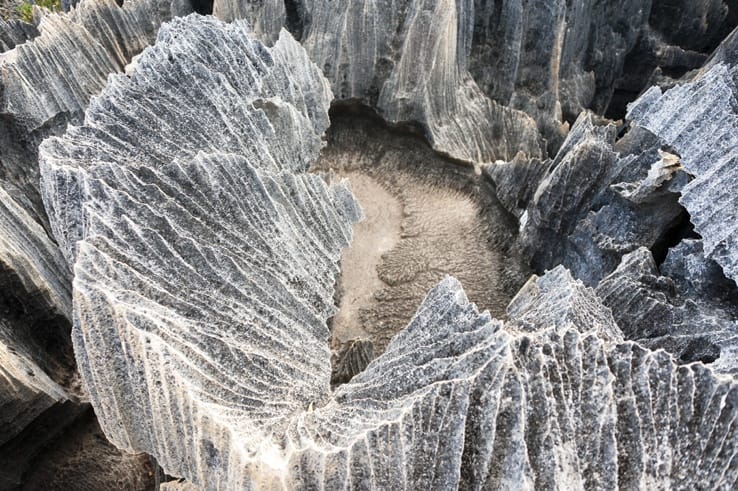
The Tsingy are an environmentalist’s dream; much of the area beyond national park boundaries is still unexplored, harbouring unknown species. Scientific expeditions always bring a plethora of discoveries; tiny frogs, long-legged lemurs, minuscule jumping rats, plants and flowers.
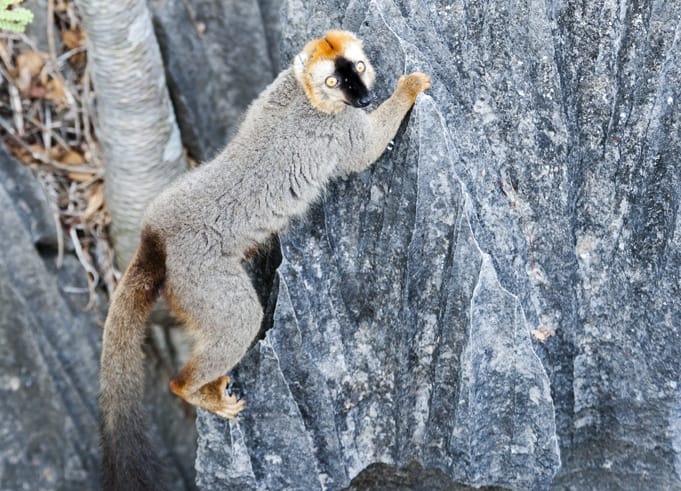
The looming landscape of spires, towers and narrow canyons (some less than a meter wide) have always discouraged humans from exploring. Local villagers believed the Tsingy were home to evil spirits and never ventured deep inside. Some caves were – and still are – used for ancestor worship. When we visited, we found melted wax and the remnants of a recent fire.
At the end of the day, we climbed to a viewpoint and watched brown lemurs climb over the rocks, then leap from a spire to another. One, then two, a male and a female, chasing each other and playing hide and seek behind the pinnacles.
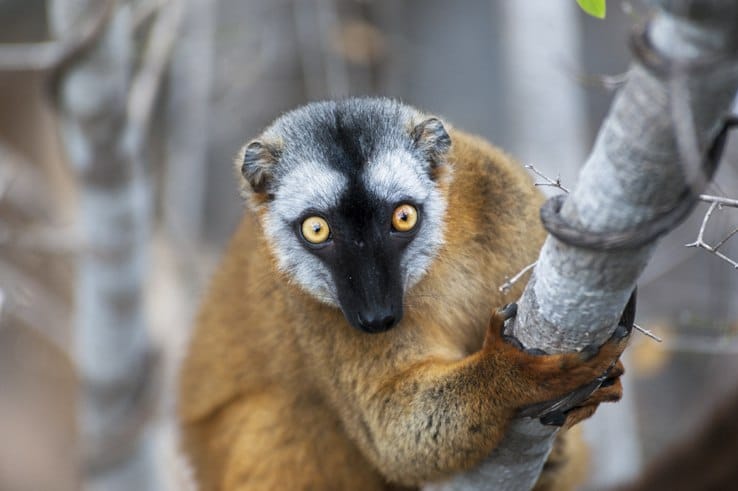
The origin of Tsingy
The rocks were razor-sharp, and even with footholds, we had to watch where we put our hands and feet. As a rock-climber, I know limestone; but I had never seen anything like that. In Malagasy, the world tsingy translates as ‘walking on tiptoe’. Watching a bright red dragonfly land on the edge of a rock, it was immediately clear why it earned its moniker.
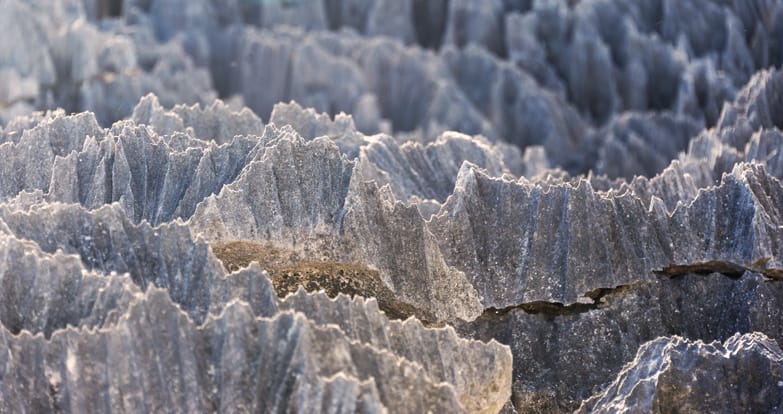
As is the case with limestone, the Tsingy were once under the sea. The ocean submerged the rocks, then retreated, repeating the process several times over the course of millions of years. The limestone was dissolved and sculpted by the action of water; rain seeped through the porous stone, corroding it into the knife-edge formations visible today.
Grand Tsingy
The dramatic landscape is at its most spectacular in the Grand Tsingy section of the park. The circuit takes visitors to the top of the rocks, thanks to a via ferrata system of cables, ladders and footholds.
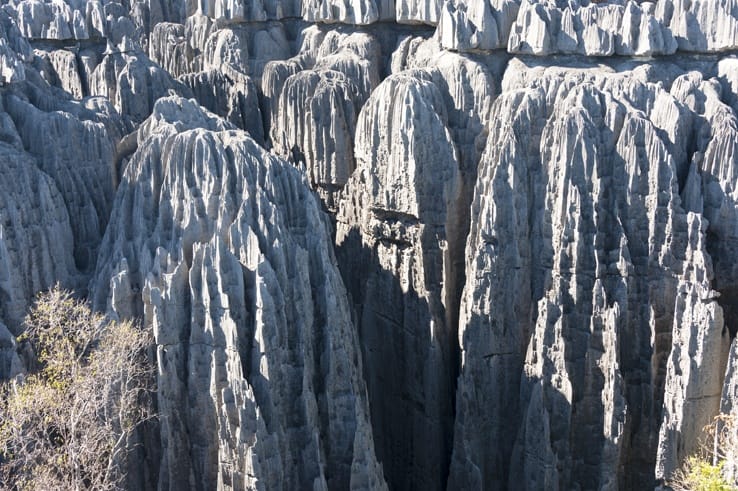
The entrance to the tsingy was pitch dark. No wonder the locals never made it in there. Two walls of limestone converged, leaving a gap that was barely enough to squeeze through. The opening over our heads was so narrow that only a slice of sky could be seen.
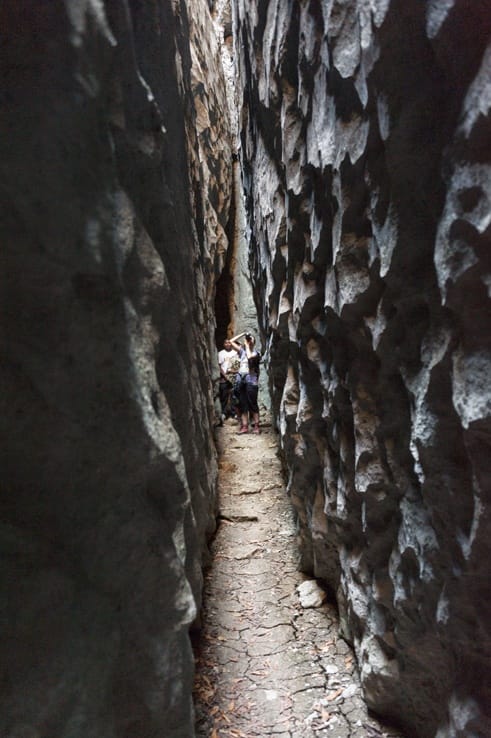
Gradually, we climbed. One rock spire after another; ascending, then descending, then repeating the process over and over again until we reached the top. And what a view. The landscape of the Great Tsingy has been called nature’s version of New York. The top looks like a chaotic maze of towers, pinnacles and spires; at the bottom, you’ll find they’re actually arranged in a grid-like system, criss-crossed by Broadway-like avenues of greenery and dotted by Central Park clearings, filled with trees.

The top of the Great Tsingy rise over 100 meters high. There’s no life above, save for a few insects and birds. A few lone trees grow between the spires; some of them have roots extending for meters to the bottom. The sun shines strong and unforgiving, the heat is stifling even early in the morning.
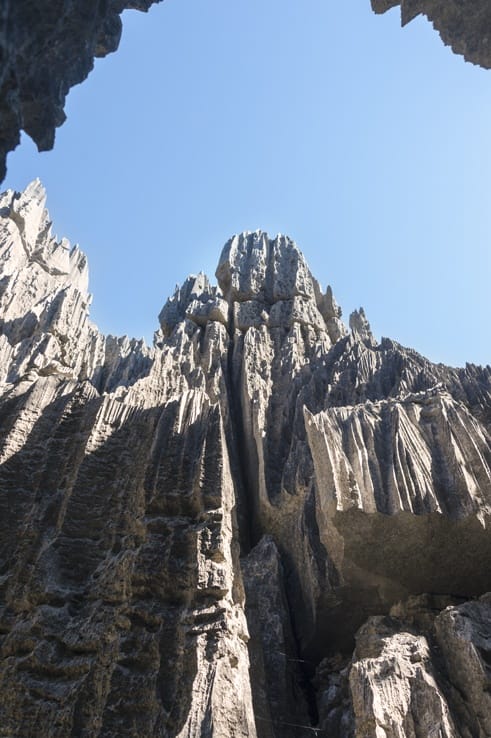
We crossed an Indiana Jones style suspension bridge, strung between two sides of a canyon. I stopped in the middle, and looked below. The bridge swung slowly back and forth, rocked by the breeze. At the bottom of the canyon was a triumph of green. Moss green, pea green, grass green, dark green, emerald green. Trees, bushes and shrubs, hiding mysterious wildlife, an ecosystem that scientists have only started exploring.
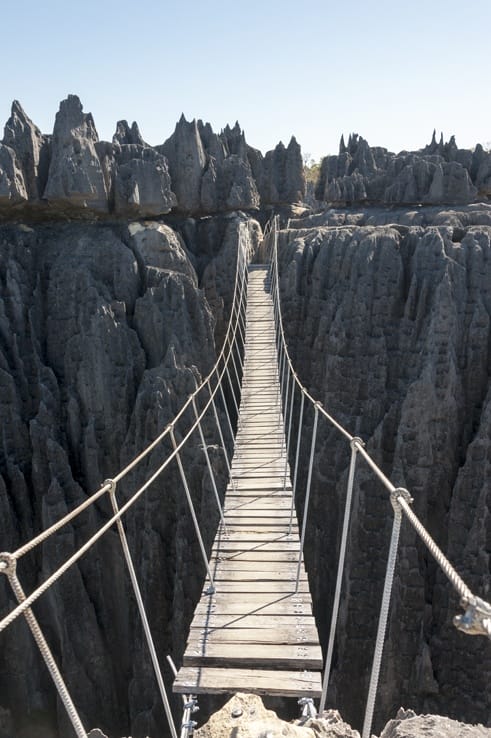
Carefully, we descended back to the bottom, holding the sharp rocks. In some cases, the knife-edge erosions were horizontal as well as vertical, giving the rocks an even more precarious look. We squeezed through ravines and caves, sometimes so low we had to proceed on all fours.

I stole a last glance before walking back to the park entrance. From the outside, the tsingy had been compared to a gothic cathedral. I found they looked more like a gateway to the underworld. The slate-grey spires reached high towards the sky, much higher than the treetops. I understood why the locals never went in. It did look like the abode of monsters. Now, I can’t help but wonder of the mystery the tsingy conceal, deep beyond.
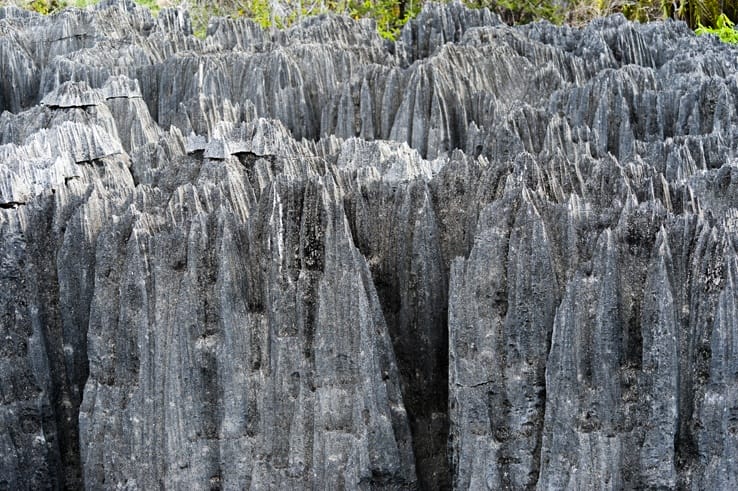
We would like to thank Lanto of Madagascar Tropic Voyage, who generously offered a media discount in exchange for consideration for an article. We loved the experience and, as always, all opinions are our own.

THIS IS SO COOL!!!! I had no idea. Fantastic!
Thanks for stopping by Jessie! It’s a crazy place 🙂
It’s the greatest feeling when childhood dreams are coming true. I am glad it was totally worth it that you waited so many years for the trip.
I’ve never thought about going to Madagascar.. now I definitely need to go there, too!
It’s one of the most beautiful things to see animals in the wild, without being under human control. That’s how it should be. And the LEMURS! I’m so jealous! Those are one of my favorite animals.. did they jump on your head? 😉
Hey Mimi! They didn’t jump on my head unfortunately, they were wild! But there’s a place near Tana (the capital) with semi-tame lemurs that you can play with. Not sure I would go there though, seems kinda wrong!
Ahh, I love all the photos of the lemurs! Especially the leaping sifaka! This place looks amazing–I would love to visit!
It’s so beautiful, you guys would love it. the nature and adventures are unique!
Wow! How amazing it would be to see a lemur in the wild like that! What a wonderful experience this looks to be!
So amazing! I loved it!
Wow! I’ve always wanted to go to Madagascar for the wildlife, but I had no idea that this stunning place existed. Awesome photos!
You’d love it Erin, you should visit!
You are nuts.
Oh my god my heart is racing. That SUSPENSION BRIDGE….IT IS CRAZY. I had no idea what a wimp I was until I read this post. I don’t think I could do it….I just don’t. I mean, I’m so glad you did and that you lived to tell the tale, but that bridge is INTENSE.
Everything about this post is incredible. The scenery and the leaping leamers, stuff of legends. i had no idea that Madagascar had so much to offer.
Do you ever do budget recaps of your vacations? Was it expensive to fly there?
I’m so glad you’re alive lady!
Hey Angie! Thanks for stopping by 🙂 I’m pretty bad when it comes to budget, but I did keep my expenses to do a guest post on a fellow blog and I can tell you that we spent about 900€ each for the 5 weeks there. The flight was more expensive than the whole stay; 1300€ each. It was a very expensive holiday for our standards, but an amazing one!
Wow, what an unusual place. It kind of reminds me of that place in the Lion King where all the bad things happen!!
I think I have to watch the Lion Kind again!
I just love that you saw this place when you were 15 on a mag, and now you’ve explored it and taken fab photos yourself. Travel is so amazing!
It was an amazing dream coming true! Loved this place, it was the highlight of my time in Madagascar!
It looks deadly, yet right out of a movie too. Be careful you don’t slip! That’d be a bad fall but looks like you got close up to see a lot of its’ beauty.
Oh, I can’t even imagine how bad it would be to slip onto one of those rocks! They were so sharp!
Wow, everyone elses comment is Wow and you have really nailed the Wow factor here! What an amazingly cool place that we now really really want to visit.
Oh, you should! You won’t regret it 🙂
Wow, what an amazing adventure! The Tsingy de Bemaraha looks other worldly. Your storytelling beautifully captured the experience. I felt like I was right next to you peering up, ducking my head, crawling on all fours and looking for the next foothold.
Thank you Mary. I am happy I was able to convey the magical feeling of that place through my writing. It was an amazing experience, a must for all nature lovers.
You’ve given me such an urge to travel to Madagascar! What incredible geology and a fascinating landscape. I would love to wander through such an interesting place, taking photos and exploring the rocks. Thanks for sharing your beautiful photos and story. Well done 🙂
Thanks Kate! I hope you do get to go and enjoy the amazing nature… it’s a great place!
Only a writer,a poet,a traveller and a child can define The beauty of nature .Famous Poet William Wordsworth has define ‘The Beauty of Nature’ as a small child “Lucy” in his poetry “Lucy Gray” and famous Hindi poet Jayshankar Prashad has define in the character of “Manu” and “Shraddha” in his famous book “Kamayani”.Thank you for sharing such post….You have proved the role of writer to defining the beauty of Nature.God bless you,best of for writing…
Thanks Abhay. This is a beautiful comment and it really made my day. I’m really happy you believed I am able to convey the beauty of nature through my words. Thanks from the bottom of my heart.
The more I read and see photos of Madascar the more I want to go, it really looks amazing and I love how rich the wildlife is, plus those landscapes are stunning!
I’m sure you and Dale would love it. The scenery is so wild and beautiful and there are very few tourists, locals are friendly and welcoming! the only issue for you guys might be the food. Local restaurants would probably give you a bucket of plain white rice and not much else, but fear not, there are many French restaurants that offer veggie and vegan food!
Thanks Liz! I’m sure you’d love Madagascar, and Tsingy was definitely THE highlight for us. Such a stunning place! BTW, your blog sounds super cool! I can’t open it unfortunately, I keep getting error messages, perhaps because we’re still in Iran. As soon as I get to Milan, I’ll check it out. take care and speak soon!
Hi Margherita
I fell in love with Madagascar years ago, because I read a book : Maverick in Madagascar by Mark Eveleigh. It was a dream…not anymore.
Next year we will start our second BIG TRIP ( we know when we leave, but we never know when we’ll be back !). We go to Africa…an itinerary of 16 countries AND Madagascar is one of them.
My dream comes true…
Thank you for reminding how special Madagascar is..
That is amazing Daniela! Where else are you going? Do you already have an itinerary for your Madagascar trip? Let me know, I’m always happy to help!